Today’s marketing landscape is complex, busy and data-driven. Trying to keep up without streamlined processes, skilled people, and fit-for-purpose technology is an endless uphill battle.
Marketing Operations for CMOs is fast becoming a priority. As we transition to a world without third-party cookies, where consumers control their data, balancing analytics and strategy is more critical to success than ever. Likewise, as budgets remain tight and competition increases unabated, agile campaign management processes and solutions enable speed and quality for busy marketing teams.
CMOs are taking notice of the operational efficiencies, process improvements and innovations that a well-tuned MarOps function delivers. They’re also taking stock. If you’re one of the CMOs turning your focus internally to find efficiencies and growth potential, you’re already on the journey to stepping up Marketing Operations capabilities.
This guide will help you formalize, strategize and operationalize. It will challenge conventional ideas about Marketing Operations, and will reposition marketing technology as a strategic tool, not an afterthought.
Ultimately, we hope it puts a framework around your goals and leads to a future-ready Marketing Operations function.
MarOps is having a moment:
- 73% of top-performing companies are investing in MarTech
- 93% of B2B marketers believe Marketing Operations is mission critical
- 75% of marketers report on how campaigns influence revenue
- 76% of companies use marketing automation
How do you define Marketing Operations?
The exact definition of Marketing Operations is up for debate. So is the correct abbreviation: MarOps? MOps? MO Pros? Marketing Ops? MO? It might seem arbitrary, but the definition significantly impacts the scope of Marketing Operations within a business.
For example, some sources define Marketing Operations as being responsible for the people, processes, strategy and technology within the marketing organization. Others demote Marketing Operations to a delivery service, leaving strategy and optimization off the list. Others bloat the function until it effectively is the marketing organization.
So, to avoid any confusion, here’s how Mediatool defines Marketing Operations:
Marketing Operations is responsible for the systems, tech stack, strategy and resources that enable the broader marketing organization to perform at the highest level.
(And we settled on “MarOps” as the best abbreviation.)
In an organization, MarOps serves as the analytical and strategic core that propels growth, with a balanced focus on technology, process, and people. This encompasses various aspects like overseeing marketing campaigns, utilizing marketing automation platforms, and managing customer data to reinforce the overall marketing strategy.
The marketing operations strategy, guided by marketing operations managers and marketing ops teams, plays a pivotal role in the success of the marketing department, directly impacting business processes, marketing effectiveness, and campaign management.
The goal of MarOps is not just to operate efficiently but to drive strategic planning, lead generation, digital transformation, and contribute to achieving business goals.
This involves continuous assessment and improvement of marketing processes, campaign performance, and customer experience. The marketing operations department, supported by tools like marketing automation platforms, helps streamline these activities, ensuring that the marketing team can adapt to new marketing processes and deliver on key responsibilities.
Ultimately, MarOps supports the marketing organization in making strategic decisions, managing marketing data, and aligning marketing efforts with the broader objectives of the business.
The recent rise of Marketing Ops
The rise of Marketing Operations Management is driven by three main factors: the increasing complexity of MarTech, a shift in focus by CMOs and COOs towards results-driven approaches, and the evolution of marketing from a predominantly creative field to one requiring technical expertise.
Modern marketers need not only creative and interpersonal skills but also a proficiency in analytics and software. This change has led to marketing teams, rather than IT departments, taking ownership of marketing platforms and tools, creating specialized roles in Marketing Operations.
This shift poses challenges for CMOs in resource allocation and investment decisions, which depend on various factors like the organization’s maturity, growth goals, risk appetite, in-house capabilities, and availability of skilled professionals. Despite these complexities, there are effective strategies for building a Marketing Operations team that contributes to sustainable business growth.
Glossary of helpful terms
Marketers enjoy an abbreviation. Maybe a little too much sometimes. You’ll see these terms pop up a few times throughout this guide, so let’s get the definitions out of the way first.
- CMO = Chief Marketing Officer
- CTO = Chief Technology Officer
- COO = Chief Operations Officer
- MarOps = Marketing Operations
- MarTech = Marketing technology
- CRM = Customer Relationship Management
- CMS = Content Management System
- CDP = Customer Data Platform
Where MarOps fits in modern companies
Let’s take a step back and look at the broader marketing organization. To understand where Marketing Ops adds value, we must first define where it begins and ends.

This diagram admittedly oversimplifies most company structures. But it’s useful for a couple of reasons: first, it separates Marketing (and MarOps) from Sales, Operations and IT, and second, it nests Marketing Operations within the broader marketing organization.
Unlike other players out there, we take the view that Marketing Operations falls under the CMO’s purview, with equal weighting to the marketing delivery arm.
In other words…
- Marketing Programs focuses on sales leads, demand generation and customer experience
- Marketing Operations focuses on the systems, tools, processes and strategies that improve productivity, reduce costs and enable growth
Another way to look at Marketing Ops is the architect of a future-ready marketing organization. MarOps provides the technology, intelligence and insight that Marketing uses to manage campaigns, produce content, connect with customers and generate leads. Of course, many of these things still happen without a mature MarOps function. But they won’t be optimized, effective or scalable.
Technology
- MarTech stack selection
- User training and onboarding
- Campaign management platform
- Data integration and management
- Performance measurement
Systems
- Project management (not campaign management)
- Workflow development and documentation
- Cross-functional collaboration
- Streamlining reporting processes
- Improving business processes
Strategies
- Competitor benchmarking
- Advising on resources, budget and hiring
- Marketing data analytics
- Finding efficiencies in (and beyond) the marketing organization
- Growth strategies
Why MarOps should be on the CMO agenda
Chief Marketing Officers have a lot on their plate. Navigating the competing demands of growth goals, budget constraints, the Great Resignation, and a cluttered MarTech landscape can feel like running on the spot. We’re not promising that investing in Marketing Operations will solve all these issues in one move (wouldn’t that be nice?). Instead, we’re encouraging CMOs to look at how their MarOps function is structured and why.
Demonstrating success with data
Marketing Ops is crucial in asserting marketing’s value in businesses, especially those undergoing digital transformation post-pandemic. Research by HubSpot shows that over 75% of marketers now link campaign performance with revenue, and understanding ROI is increasingly important.
In practice, Marketing Operations teams often work to establish connections between campaign performance and revenue generation. As the creators and facilitators of marketing data analytics, Marketing Operations is key to showcasing the marketing organization’s contribution to the business. Therefore, CMOs seeking increased budgets and effective marketing operations strategy should embrace a MarOps approach, demonstrating how technology, systems, and strategy converge to drive business success.
Delivering better experiences
It’s fair to say that linear customer journeys have gone the way of the dodo. Today’s customers are unpredictable and demanding, jumping between channels in a non-linear journey. As a result, Marketing and Sales teams are more interdependent. They share data and collaborate to reach customers with the best offer at the best time on the best channel.
But customers don’t see ‘channels’ and ‘journeys’ like marketers. They’re simply living their lives. As Google points out, most decision-making happens in the “messy middle” between the first touchpoint and point of purchase. The marketer’s job is to find their audience, understand the pain points and thrill triggers, and deliver a personalized experience that converts a sale and builds loyalty. The salesperson’s job (specifically in B2B) is to close the deal, demonstrating that they anticipate the customer’s needs and can provide a relevant solution.
How? You guessed it – data. The role of Marketing Ops is to provide the tools, reporting systems and operating structure so Sales and Marketing can find the answers themselves. This, in a nutshell, is the idea of democratizing data.
Optimizing operations
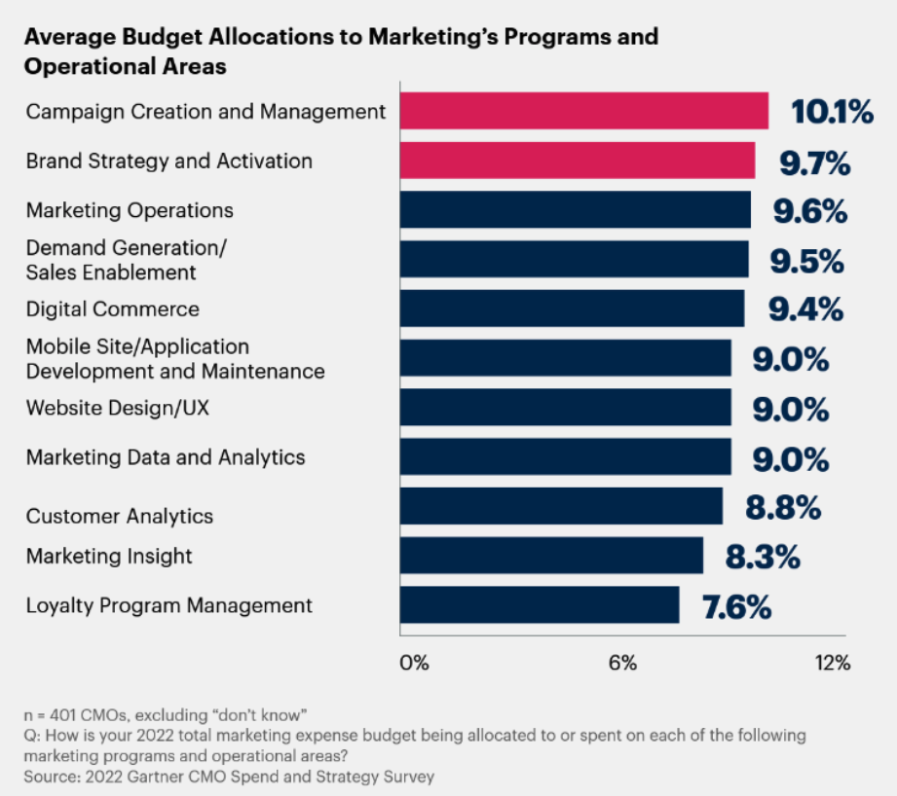
Marketing budgets are gradually recovering, with CMOs adopting a back-to-basics approach, emphasizing campaign management, brand strategy, and Marketing Operations. A significant part of the budget is allocated to marketing data analytics, insight, and customer analytics, while front-end elements like apps, UX design, loyalty programs, and eCommerce are being deprioritized to focus on strengthening foundational aspects.
This trend indicates a shift towards viewing Marketing Ops as a key driver of growth, with analytics and campaign management capabilities central to achieving strategic, data-driven growth objectives.
Unlocking efficiencies
In 2020, Gartner research revealed that while MarTech constituted 26% of marketing budgets, marketers were only utilizing 58% of its potential, indicating premature investments in technology. Two years later, some businesses might be stuck in a sunk cost fallacy, continuing to invest in tools without a clear Marketing Ops strategy.
CMOs should intervene to eliminate these inefficiencies, starting by reassigning ownership from Marketing Programs to Marketing Operations. This shift repositions MarTech tools as strategic assets rather than mere delivery resources. Every component, be it a Customer Data Platform, campaign management platform, or email automation tool, should serve a strategic purpose and contribute to growth.
Streamlining systems
A well-functioning Marketing Ops team streamlines marketing and interdepartmental processes by standardizing workflows, automating tasks, and making data accessible. While CMOs may not directly change organizational structures, they can enhance operations by:
- Encouraging cross-departmental collaboration.
- Democratizing data access for informed decision-making.
- Setting clear marketing success metrics.
- Optimizing workflows throughout the business.
Effective Marketing Operations should eliminate roadblocks in advertising or campaign launches. The focus is on avoiding both excessive processes and disorganized, last-minute efforts that lead to poor outcomes. Essentially, Marketing Operations acts like a Process Engineer for marketing activities, ensuring smooth, efficient operations from concept to campaign execution.
Delegating fire-fighting duties
In an effective Marketing Operations (MarOps) setup, day-to-day technical issues like bug fixes or platform adjustments should be handled by platform specialists or IT, not MarOps. The goal of MarOps is to proactively prevent issues rather than reacting to them.
Achieving this level of operational maturity requires time. Initially, CMOs should monitor progress and team feedback to prevent burnout from out-of-scope tasks. Middle management, such as the Head of Marketing or Marketing Operations Lead, should focus on sustainable solutions over quick fixes.
For instance, rather than having marketing specialists correct individual records in a CRM, prioritize a comprehensive data clean-up program. Similarly, instead of marketers spending hours on spreadsheets for campaign data, invest in an integrated campaign management platform for efficiency, collaboration, data accuracy, and easier decision-making.
We’re not there yet
A near-unanimous 93% of B2B marketers agree that Marketing Operations is mission critical, especially in delivering digital transformation. And yet, only 50-65% of companies have a dedicated Marketing Ops team or leader.
One in four professionals in the field are working alone, and nearly one-third (32%) don’t have a defined role. If Marketing Operations is vital to growth, why are companies still struggling to embed a functional team?
The Cost Question
Building a Marketing Operations team is an investment. In theory, one that delivers significant, exponential and wide-ranging ROI. But budgets aren’t bottomless, and the person holding the business’ purse strings needs to decide where those limited funds are best spent.
The Priority Problem
Which comes first – technology and systems or the Marketing Operations strategy? CMOs often end up in an endless cycle of indecision because there isn’t a single correct answer. The answer is to be agile. Trial low-risk initiatives and build from there.
The Knowledge Gap
Most CMOs understand the importance of Marketing Operations in a technology-driven landscape. Can the same be said for CEOs and CTOs? And who gets the final say? Raising awareness of the Marketing Operations function remains a challenge, even as the C-Suite demands to see data and results.
Marketing Operations models
Just as there is no universal definition of Marketing Operations, no two businesses build their team the same. Mostly, this has to do with the dual nature of MarOps. It’s both integrated and independent, simultaneously strategic and operational.
Ultimately, that means the Marketing Operations model that suits your business will be unique. However, it is still possible to learn from other companies’ successes and model your Marketing Operations structure (at least the initial version) on best practices.
Break down the challenges
Building a Marketing Operations team is a little like strategizing a marketing campaign. It begins with enterprise-wide goals and marketing’s role in reaching them. Audiences and key stakeholders come next, each with their own pain points and positive triggers. Then a channel plan starts to form. This is your MarTech stack and systems design, and a Marketing Operations mindset is already kicking in. Finally, the timeline and content schedule – otherwise known as the CMO’s plan for filling out the team’s capabilities.
The result is a roadmap to maturity.
The MarOps maturity model
Going back to “The Priority Problem” outlined above, don’t expect your organization to have a fully matured Marketing Operations function from day one. It is typically more practical to develop in stages by adding capabilities, restructuring, formalizing and investing in MarTech as you go.
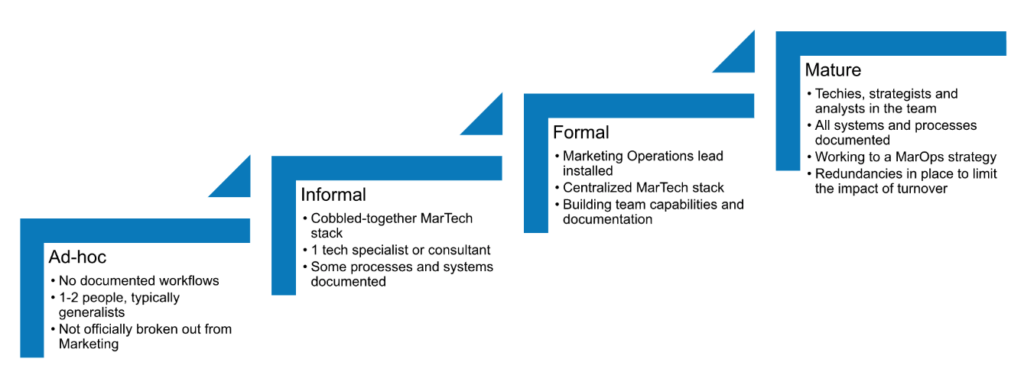
But, as these things go, no model applies universally. For example, an industrial manufacturer selling multimillion-Euro machines will have a distinctly different MarOps requirement than an eCommerce company selling consumer goods. Marketing Operations is a strategic function. It should serve a strategic purpose. But strategy without operational efficiency is empty.
So it might seem contradictory to have MarOps people in operational roles, but that’s often a valid approach – at least in the early stages of maturity. Or your Marketing Operations team might be entirely strategic. It all comes down to the company’s needs. Which, as we all know, begin and end with the customer.
Marketing Operations models for modern businesses
(Quick disclaimer: these models are for illustrative and inspirational purposes only. If they seem reductive, that was a deliberate choice not to overcomplicate things).
The classic

The line between Programs and Operations is clear in this model, which will be familiar to CMOs with established MarOps functions. Marketing Operations do the planning and enablement work while Marketing Programs deliver front-facing campaigns. Requests to and from other teams flow through the Head of Marketing.
The tech stack trailblazer

Ingrained MarTech expertise is the goal here. Marketing Operations becomes the owner, guru and guide for the full MarTech stack. Although this relegates the marketing team to an enablement partner (and could be seen as a demotion), the advantage is an unbiased tech solution that serves the entire organization equally.
The lead gen engine
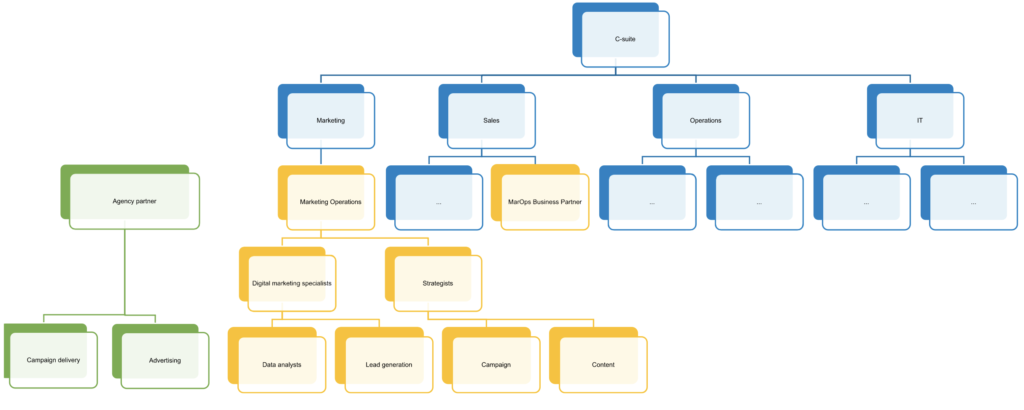
Growing businesses might lean towards a model like the lead gen engine, where the marketing organization outsources delivery to a third party. Marketing activity becomes sales driven. Every decision, for better or worse, is based on reaching growth targets and bringing in new business. Marketing Operations relies heavily on data analytics to translate sales goals into marketing strategies.
The efficiency evangelists
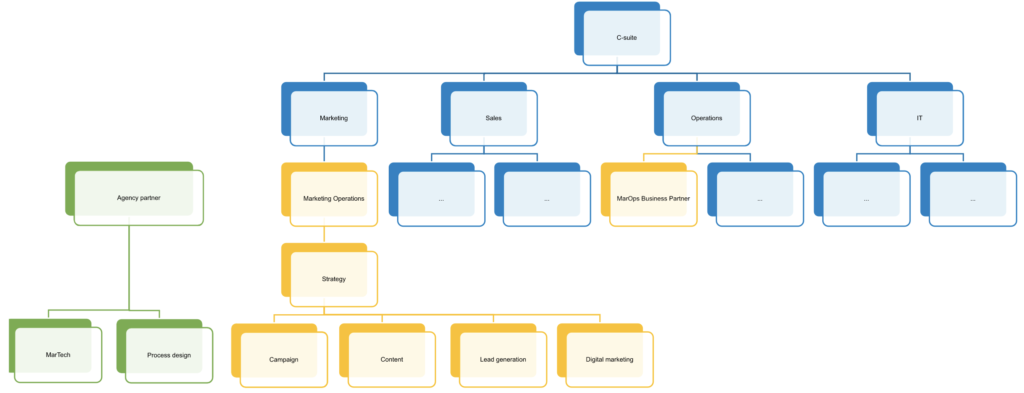
It’s all about trimming waste and improving processes. Most of the hands-on MarTech work is outsourced to an agency partner, because the MarOps team is focused on operational efficiency at the strategic level. This model keeps overheads low and prioritizes value-adding activity, but you’ll notice Marketing Operations is missing. MarOps essentially is the marketing organization, which means content creation and marketing campaigns become by-products.
The agile adapters
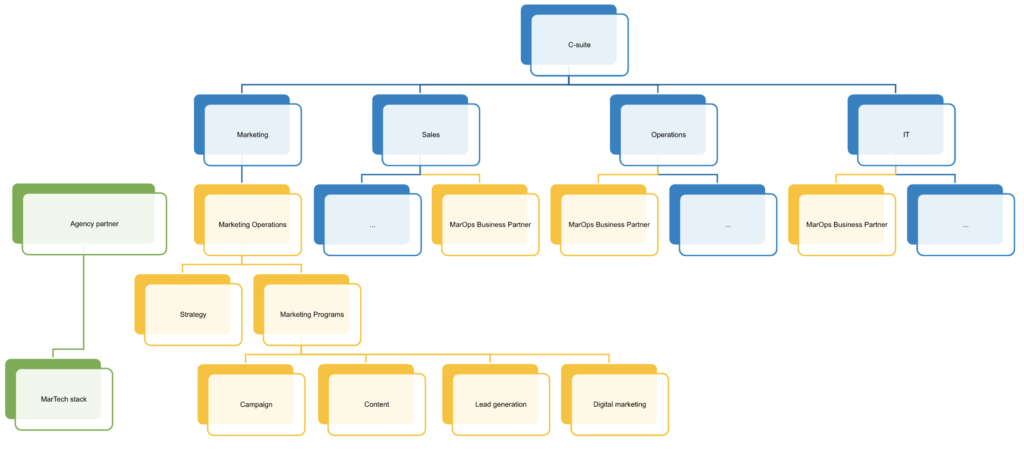
The agile adapter model might be closest to the ideal state for any business. Business Partners in different teams ensure buy-in and provide valuable guidance, essentially flipping the tech stack trailblazer model on its head by democratizing decision-making. External MarTech specialists implement and maintain the platform under direction from the MarOps team, although this function could gradually be in-housed as the business grows.
How CMOs can transform Marketing Operations in 5 steps
CMOs can transform Marketing Operations (MarOps) in five streamlined steps:
- Scoping Exercise: Begin by understanding MarOps’ scope, consulting with various departments to identify business challenges and define how MarOps will support the organization.
- Inclusive Workshop Solutions: Include stakeholders from all levels, not just the C-suite, to gather diverse inputs for a comprehensive marketing operations strategy.
- Long-Term Planning: Design MarOps to be agile and scalable, focusing on strategic planning for future business growth and challenges.
- Announce and Refine the Plan: Share the MarOps plan openly across the organization, welcoming feedback and being prepared for digital transformation challenges.
- Implementation and Prioritization: Deploy the MarOps structure, possibly with external support, prioritizing long-term growth and aligning decisions with business goals.
Key to this process is engaging the marketing operations team and professionals in aligning with the marketing strategy, utilizing marketing automation tools, and effectively managing marketing data and processes.
How Marketing Operations project should look

How they look in reality

Monitor and maintain communication
Throughout the Marketing Operations rollout, whether it takes months or years, your role as CMO is essentially two-fold.
Transforming Marketing Operations (MarOps) requires CMOs to evaluate outcomes and maintain communication effectively.
This involves:
- Evaluating Outcomes: Assessing the impact of changes in MarOps, such as time savings from marketing automation platforms and lead generation from marketing campaigns. Even less tangible projects, like CRM clean-up, contribute to staff retention and productivity.
- Maintaining Communication: Keeping the entire marketing team, including marketing ops professionals and managers, informed and involved. This includes celebrating progress, addressing challenges, and aligning changes with the overall marketing strategy and business goals.
Key to this transformation is integrating marketing technology, managing marketing data effectively, and focusing on customer experience and campaign performance. The marketing operations team, supported by digital marketers and the creative team, plays a crucial role in this digital transformation, contributing to the marketing department’s efficiency and effectiveness in achieving strategic objectives.
Building a scalable MarTech stack
Technology plays a significant role in building out a Marketing Operations function. A mature MarTech stack will unlock insight, automate time-consuming tasks, inform strategy, and enable Marketing Programs to optimize campaigns. So why have we, a marketing technology leader, left it so late in this guide? Primarily so the focus stays on strategy, and MarTech follows as a strategic enablement tool.
Before buying a license, consider whether the technology supports the growth your company is targeting. McKinsey found that 73% of the top-performing companies are investing more in MarTech. The focus, earning 63% of CMOs’ attention, is on using MarTech to inform strategy. Automation and campaign execution comes next at 41%, followed by CRM optimization at 37%.
In short? High-performing businesses invest in new technology strategically. Know the problem you want to solve and build the MarTech stack around it.
That’s great in theory, right? In reality, you’re likely dealing with a cobbled-together MarTech stack or a platform nearing the end of its useful life. Implementing a scalable MarTech framework might mean having some tough budget conversations.
The only mistake is to fall into a sunk cost trap, where you continue trying to retrofit a stack that won’t deliver what you need. The earlier you switch to an all-in-one campaign management solution, the more you stand to gain.
Involve IT early and often
It’s also crucial to secure IT support, rather than being tempted to sidestep the ecosystem. McKinsey also reports, somewhat worryingly, that 45% of executives said Marketing and IT aren’t working together. At some point, rogue MarTech arrangements are either replaced entirely or integrated into existing business systems. Both scenarios are frustrating and expensive.
The all-in-one campaign management solution for the modern marketing operations team
There’s an inflection point in every Marketing Operations maturity model. It arrives when the CMO recognizes that future growth depends on investment. Until that point, a piecemeal MarTech stack and half-documented processes have almost been enough. But now you’ve hit a ceiling and stakeholders are asking to see results.
This inflection point is exciting. With the right investment, you can demonstrate ROI and improve audience interactions in one move. It all depends on finding a platform that ties everything together and sets you up to scale.
That’s Mediatool in a nutshell
Mediatool is a marketing campaign management platform designed for growing agencies and busy global marketing teams. The features, functionality and third-party integrations unlock productivity at every stage of the marketing campaign process.
Planning
- Create marketing plans without spreadsheets
- Merge marketing data into one platform
- Share plans with external partners
- Organize plans in folders
- Protect privacy with secure sharing
Collaboration
- Share and comment on marketing plans
- Automatic version tracking
- Collaborate internally and externally
- Streamline approval processes
- Establish goals and KPIs
Measuring
- Integrate all your marketing channels
- Consolidate data in real time
- Eliminate information siloes
- See all your marketing data in one place
- Track performance at a glance
Evaluating
- Filter dashboard data to find insights
- Create custom reports in seconds
- Demonstrate ROI with charts and graphs
- Structure dashboards however you like
- Compare data from multiple channels
Optimizing
- Free up time for strategy
- Use data to make more informed decisions
- Get the whole picture
- Easily share insights with colleagues and clients
- Gain confidence from more accurate data
What’s next for Marketing Operations?
Research from Gartner shows digital transformation is a priority for 22% of CEOs, up from 10% previously. Technology innovation is a target for 17% of CEOs, up from 9%. These used to be the CMO’s domain, but they’ve become enterprise-wide priorities. That doesn’t reflect a demotion as much as a collaboration opportunity.
Meanwhile, eCommerce and omnichannel capabilities are less of a priority, falling from 16% to 4%. It’s unclear whether it’s widely understood that these outcomes rely on MarOps, or CEOs are reprioritizing to focus on tech instead of strategy. But the message isn’t. Marketing Operations is in the spotlight, and expectations are high.
Moving forward, you can use the examples and models in this guide to think about your own organizational structure. Challenge the ideas as you would have others challenge your thinking. Read widely. Take calculated risks.
There is a correct answer to Marketing Operations. It’s the one that enables your business to grow, remain agile, and compete in an increasingly complex field.




